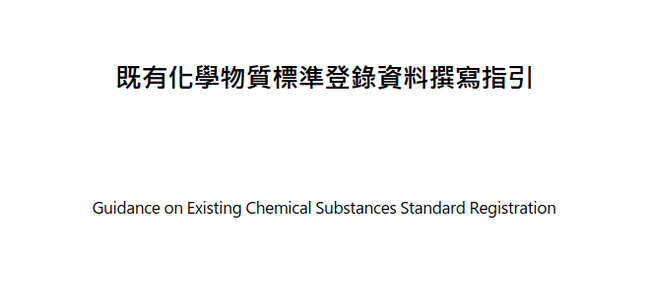9 Jun. 2020, Taiwan released the Guideline on Existing Chemical Substance Standard Registration (First Edition). Compared with the Draft released in September 2019, the Guideline gives more details and will better help enterprises understand the requirements of existing chemical substances standard registration.
The Guideline covers six chapters and an appendix. Details are as follows:
|
Guideline on Existing Chemical Substance Standard Registration (First Edition) |
|
|
Chapter One |
Terms and Regulations: Explain the rules of the Guideline as well as definitions of the terms; |
|
Chapter Two |
Workflow Confirmation: Help enterprise confirm the registration obligations and explain the relevant requirements, including the registration period, registration type, etc.; |
|
Chapter Three |
Exemption: Explain the exemption situations; |
|
Chapter Four |
Registration Material: Provide the contents of Item 1-9 registration materials; |
|
Chapter Five |
Principles for Registration Material Preparation: Provide suggestions for physiochemical, toxicological and eco-toxicological data preparation; non-test data is recommended; |
|
Chapter Six |
Registration review, management and information disclosure: Clearly stipulates enterprises’ the rights and obligations; |
|
Appendix |
Information including Hazard substance classification table, criteria for judgment of PBT and vPvB substances , guidelines for QSAR report and systematic literature review report preparation |
Compared with the Draft, what are the new requirements that enterprises should pay attention to? What should enterprises do to cope with the changes?
1. Changes to Data Requirements
Compared with the Draft, the Guideline has newly added the data requirements for the following endpoints: Genotoxicity, repeated exposure to toxicity and reproductive/developmental toxicity.
|
Dat a Requirements |
Draft |
Guideline |
|
Genotoxicity |
Level I Standard Registration, bacterial reverse mutation information shall be submitted; |
Level I Standard Registration, bacterial reverse mutation information shall be submitted; If it is tested positive, then in vitro mammalian cell genotoxicity information is required; if the in vitro mammalian cell genotoxicity is tested positive, then in vivo genotoxicity information shall be submitted. |
|
Level II Standard Registration, In vitro mammalian cell genotoxicity and in vivo genotoxicity information shall be submitted; |
Level II Standard Registration, bacterial reverse mutation information and in vitro mammalian cell genotoxicity information shall be submitted; If either one is tested positive, then in vivo genotoxicity information is also required; |
|
|
Level III and Level IV Standard Registration, in vivo genotoxicity information shall be submitted; |
Level III and Level IV Standard Registration, bacterial reverse mutation information, in vitro mammalian cell genotoxicity and in vivo genotoxicity information shall be submitted; |
|
|
Repeated exposure to toxicity |
Level III and Level IV Standard Registration, 90-day repeated toxicity information shall be submitted; |
Level III and Level IV Standard Registration, 28-day repeated toxicity information and 90-day repeated toxicity information shall be submitted; |
|
Reproductive/developmental toxicity |
Level IV Standard Registration, two generation reproductive toxicity information shall be submitted; |
Level IV Standard Registration, developmental toxicity during pregnancy and two generation reproductive toxicity information shall be submitted; |
When carrying out existing substances standard registration, enterprises should prepare the registration data in accordance with the data requirements and exemption principles recorded in the Guideline. It is worth mentioning that as enterprises are recommended to use non-test data, thus the change to data requirements will not largely increase enterprises’ economic burden.
2. Recommend non-test data and increase international open database
In accordance with the requirements of Chapter Five of the Guideline, enterprises are recommended to prepare the physiochemical, toxicological and eco-toxicological data by making reference to the information recorded in international open database, including International Labor Organization (ILO), World Health Organization (WHO), International Agency on Cancer Research (IRAC), US Environmental Protection Agency (US EPA), the United Nations, etc.
Compared with the draft, the number of recommended international database has increased. Enterprises are encouraged to use non-test data as a priority, which will greatly lower enterprises’ difficulties, such as information collection. Considering the copyright, when using the data in database, enterprises should directly quote the data.
In addition, the Guideline also mentioned the situations where read-across can be applied.
3. Registration number will be issued after submission of Item 1-7 registration materials
In accordance with the Chapter Four of the Guideline, the registration number for existing substance standard registration will be issued to the registrants after the registrants have submitted the materials from Item 1 to Item 7 and successfully passed the review.
If Item 8 (hazard assessment information) and Item 9 (exposure assessment information) are required, Agency will help enterprise supplement the required information within the specified time limit.
4. The Guidelines for Chemical Hazard Assessment and Exposure Assessment is to be released
The Guidelines for Chemical Hazard Assessment and Exposure Assessment is an important guiding document for existing substance standard registration. It will stipulate the category, workflow, requirements and method of hazard assessment and exposure assessment. The Guidelines are still under compilation and will be released in the future.
5. The number of testing organizations has increased
Testing organization of toxicology and eco-toxicology: laboratories that comply with ISO 17025 are added;
Testing organizations of physicochemical properties, toxicology and eco-toxicology: laboratories in colleges in Taiwan are added;
That is to say, enterprises may have much more choices in testing organizations.
If you would like to know more about the Guideline, please contact us at service@hfoushi.com.
Reference:
Taiwan EPA News


